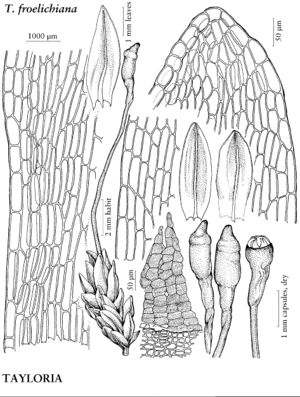Tayloria
J. Sci. Arts (London) 2(3): 144. 1816.
| Taxon | Illustrator ⠉ | |
|---|---|---|
 | Tayloria froelichiana | Patricia M. Eckel |
 | Tayloria hornschuchii | Patricia M. Eckel |
 | Tayloria serrata | Patricia M. Eckel |
Plants in loose or dense tufts, green, yellowish, or sometimes brownish. Stems 0.5–3 (–6) cm; sparsely to strongly radiculose. Stem-leaves oblong-lanceolate to obovate; margins toothed to entire; apex obtuse, blunt, acute, or acuminate; costa ending well before apex to excurrent; proximal laminal cells long; distal cells oblong-hexagonal. Sexual condition autoicous, often dioicous, rarely synoicous. Seta 0.6–4 cm, flexuose or twisted. Capsule not cleistocarpous, brown, ovoid, oblong-cylindric, pyriform, or conic; hypophysis usually same color as urn, short-to-elongate, narrower than or occasionally as wide as urn; annulus present, not strongly differentiated; operculum flat, convex, conic, or hemispheric; peristome inserted at or below mouth, prostome absent (present in T. lingulata); exostome teeth 8 or 16, sometimes connate in pairs, rarely split, erect or reflexed, of 2 layers of cells. Calyptra mitrate, short, constricted at base. Spores 9–48 µm, smooth, slightly roughened, or papillose.
Distribution
Nearly worldwide, tropical to subarctic regions
Discussion
Species 45 (6 in the flora).
Tayloria is the only genus of the family to include both anemophilous and entomophilous taxa; it is also the most polymorphic morphologically. All North American species of Tayloria are anemophilous and none are coprophilous, although the plants often grow on nutrient-enriched substrates. The hypophysis of sporophytes of Tayloria is usually tapered and constricted when dry; the stem leaves are erect to wide-spreading and imbricate to somewhat contorted when dry; and the capsules are erect to suberect or slightly asymmetric.
Selected References
None.
Lower Taxa
Key
| 1 | Leaves lingulate or rarely obovate to oblong; apices obtuse to rounded, occasionally bluntly acute; margins entire or sometimes with blunt teeth | > 2 |
| 1 | Leaves obovate, oblong, or ovate-lanceolate, rarely lingulate; apices acute or acuminate, not broadly rounded, sometimes obtuse; margins serrate distally | > 4 |
| 2 | Prostome present; setae slender, 1.5-4 cm. | Tayloria lingulata |
| 2 | Prostome absent; setae stout, to 1 cm | > 3 |
| 3 | Leaves uniformly spaced along stem, slightly contorted when dry; columella included; hypophysis as long as urn; exostome teeth lanceolate, yellow to tan; operculum deciduous. | Tayloria froelichiana |
| 3 | Leaves crowded at stem and branch apices, stiffly erect-imbricate when dry; columella exserted; hypophysis longer than urn; exostome teeth truncate to obtuse, red to red-brown; operculum systylius. | Tayloria hornschuchii |
| 4 | Exostome teeth not split. | Tayloria serrata |
| 4 | Exostome teeth split at base into linear-lanceolate filaments | > 5 |
| 5 | Plants 1-3 cm; leaf apices blunt or apiculate; setae 1.5-3 cm; capsule urns 2-3.5 mm when moist; columella exserted when dry; operculum long-conic. | Tayloria splachnoides |
| 5 | Plants 0.5-1 cm; leaf apices long-acuminate; setae 0.6-1.5 cm; capsule urns 0.8-2 mm when moist; columella not or barely exserted when dry; operculum short-conic. | Tayloria acuminata |